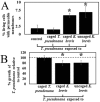Karenia brevis allelopathy compromises the lipidome, membrane integrity, and photosynthesis of competitors
- PMID: 29934632
- PMCID: PMC6015087
- DOI: 10.1038/s41598-018-27845-9
Karenia brevis allelopathy compromises the lipidome, membrane integrity, and photosynthesis of competitors
Abstract
The formation, propagation, and maintenance of harmful algal blooms are of interest due to their negative effects on marine life and human health. Some bloom-forming algae utilize allelopathy, the release of compounds that inhibit competitors, to exclude other species dependent on a common pool of limiting resources. Allelopathy is hypothesized to affect bloom dynamics and is well established in the red tide dinoflagellate Karenia brevis. K. brevis typically suppresses competitor growth rather than being acutely toxic to other algae. When we investigated the effects of allelopathy on two competitors, Asterionellopsis glacialis and Thalassiosira pseudonana, using nuclear magnetic resonance (NMR) spectroscopy and mass spectrometry (MS)-based metabolomics, we found that the lipidomes of both species were significantly altered. However, A. glacialis maintained a more robust metabolism in response to K. brevis allelopathy whereas T. pseudonana exhibited significant alterations in lipid synthesis, cell membrane integrity, and photosynthesis. Membrane-associated lipids were significantly suppressed for T. pseudonana exposed to allelopathy such that membranes of living cells became permeable. K. brevis allelopathy appears to target lipid biosynthesis affecting multiple physiological pathways suggesting that exuded compounds have the ability to significantly alter competitor physiology, giving K. brevis an edge over sensitive species.
Conflict of interest statement
The authors declare no competing interests.
Figures



Similar articles
-
Metabolomics and proteomics reveal impacts of chemically mediated competition on marine plankton.Proc Natl Acad Sci U S A. 2014 Jun 17;111(24):9009-14. doi: 10.1073/pnas.1402130111. Epub 2014 Jun 2. Proc Natl Acad Sci U S A. 2014. PMID: 24889616 Free PMC article.
-
Variable allelopathy among phytoplankton reflected in red tide metabolome.Harmful Algae. 2018 Jan;71:50-56. doi: 10.1016/j.hal.2017.12.002. Epub 2017 Dec 15. Harmful Algae. 2018. PMID: 29306396
-
Competing phytoplankton undermines allelopathy of a bloom-forming dinoflagellate.Proc Biol Sci. 2008 Dec 7;275(1652):2733-41. doi: 10.1098/rspb.2008.0760. Proc Biol Sci. 2008. PMID: 18713720 Free PMC article.
-
A review of karenia mikimotoi: Bloom events, physiology, toxicity and toxic mechanism.Harmful Algae. 2019 Dec;90:101702. doi: 10.1016/j.hal.2019.101702. Epub 2019 Nov 20. Harmful Algae. 2019. PMID: 31806160 Review.
-
The current state of knowledge on taxonomy, modulating factors, ecological roles, and mode of action of phytoplankton allelochemicals.Sci Total Environ. 2021 Jun 15;773:145681. doi: 10.1016/j.scitotenv.2021.145681. Epub 2021 Feb 6. Sci Total Environ. 2021. PMID: 33940759 Review.
Cited by
-
Precipitation, submarine groundwater discharge of nitrogen, and red tides along the southwest Florida Gulf coast.Heliyon. 2023 May 6;9(5):e16046. doi: 10.1016/j.heliyon.2023.e16046. eCollection 2023 May. Heliyon. 2023. PMID: 37215903 Free PMC article.
-
Phytotoxic Potential and Phenolic Profile of Extracts from Scrophularia striata.Plants (Basel). 2021 Jan 11;10(1):135. doi: 10.3390/plants10010135. Plants (Basel). 2021. PMID: 33440883 Free PMC article.
-
Microalgae show a range of responses to exometabolites of foreign species.Algal Res. 2022 Mar;62:None. doi: 10.1016/j.algal.2021.102627. Algal Res. 2022. PMID: 35311224 Free PMC article.
-
Brevetoxin and Conotoxin Interactions with Single-Domain Voltage-Gated Sodium Channels from a Diatom and Coccolithophore.Mar Drugs. 2021 Mar 2;19(3):140. doi: 10.3390/md19030140. Mar Drugs. 2021. PMID: 33801270 Free PMC article.
-
Allelopathy and underlying mechanism of mango (Mangifera indica) peel extracts on Alexandrium catenella.Front Plant Sci. 2024 Nov 26;15:1510692. doi: 10.3389/fpls.2024.1510692. eCollection 2024. Front Plant Sci. 2024. PMID: 39659420 Free PMC article.
References
-
- Glibert PM, Anderson DM, Gentien P, Granéli E, Sellner KG. The global, complex phenomena of harmful algal blooms. Oceanography. 2005;18:136–147. doi: 10.5670/oceanog.2005.49. - DOI
-
- Backer LC, et al. Recreational exposure to aerosolized brevetoxins during Florida red tide events. Harmful Algae. 2003;2:19–28. doi: 10.1016/S1568-9883(03)00005-2. - DOI
Publication types
MeSH terms
LinkOut - more resources
Full Text Sources
Other Literature Sources

